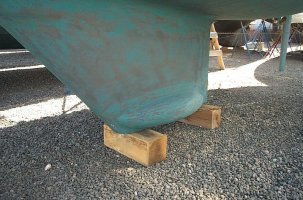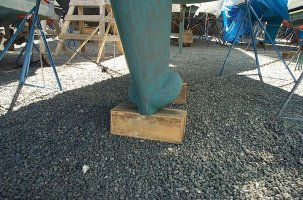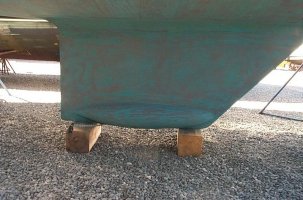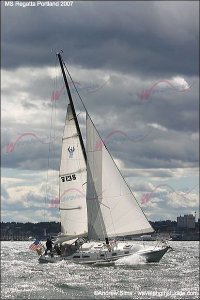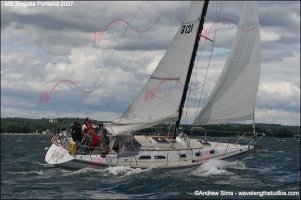Hello All,
I went racing with a club member on his C&C 35 and watched carefully how that boat was trimmed, etc. I have also spoken to a few other racers about sail trim, weather helm, etc. Then I have tried to apply this advice to my E38. I have been told that I should be able to trim the sails so the wheel is neutral or just a bit of weather helm and this will be the fastest/lowest drag, etc. My E38 just doesn't like that! No matter what I do the boat really seems to like about a 1/4 turn into the wheel, maybe 1/3rd turn at most. When I do this the boat jumps, literally, and picks up almost 1kt in speed. This is all going to weather/close hauled in 16-20kts true. 130 genoa and a full batten main. My theory is the E38 is designed like this. The boat heels, increases waterline, the offset foils generate more lift, etc. She really seems to like being sailed with the leeward toerail at least 6 inches above the water to having the toerail right at the water. I have tried sailing the boat more upright its just not as fast. Heeled over she just seems to find her groove and lock in. The only thing I have not tried is to move the traveller to windward in these conditions while easing the mainsheet to leeward with the intent of really twisting off the top of the mainsail. My main doesn't like to twist and this maybe due to the full battens? I can see how this state of trim is possibly due to the current suit of sails. I can see how the theory of keeping the rudder as close to centerline as possible will minimize drag however it just doesn't appear to work on my boat! The rig is tuned correctly, the rake is as recommended in numerous posts. Regarding speeds well I can't say for sure since my knotmeter is dead. All I have is GPS SOG. I am seeing 5.7-6+kts SOG close hauled in 16-18kts true. Sailed upright I see 5kts or less. Would she be faster if I can figure out how to trim so that the rudder is more on centerline? I have no idea. I also notice that off the wind, beam reaching or even broad reaching, 120* or so, that the rudder needs to be held 1/4 turn to leeward to hold her on course. Again, trying to trim otherwise seems to slow her down. So what say the Ericson faithful? I'm not complaining, the boat seems just fine to me. I am just trying to understand why its not responding to the recommendations of some experienced sailors. RT
I went racing with a club member on his C&C 35 and watched carefully how that boat was trimmed, etc. I have also spoken to a few other racers about sail trim, weather helm, etc. Then I have tried to apply this advice to my E38. I have been told that I should be able to trim the sails so the wheel is neutral or just a bit of weather helm and this will be the fastest/lowest drag, etc. My E38 just doesn't like that! No matter what I do the boat really seems to like about a 1/4 turn into the wheel, maybe 1/3rd turn at most. When I do this the boat jumps, literally, and picks up almost 1kt in speed. This is all going to weather/close hauled in 16-20kts true. 130 genoa and a full batten main. My theory is the E38 is designed like this. The boat heels, increases waterline, the offset foils generate more lift, etc. She really seems to like being sailed with the leeward toerail at least 6 inches above the water to having the toerail right at the water. I have tried sailing the boat more upright its just not as fast. Heeled over she just seems to find her groove and lock in. The only thing I have not tried is to move the traveller to windward in these conditions while easing the mainsheet to leeward with the intent of really twisting off the top of the mainsail. My main doesn't like to twist and this maybe due to the full battens? I can see how this state of trim is possibly due to the current suit of sails. I can see how the theory of keeping the rudder as close to centerline as possible will minimize drag however it just doesn't appear to work on my boat! The rig is tuned correctly, the rake is as recommended in numerous posts. Regarding speeds well I can't say for sure since my knotmeter is dead. All I have is GPS SOG. I am seeing 5.7-6+kts SOG close hauled in 16-18kts true. Sailed upright I see 5kts or less. Would she be faster if I can figure out how to trim so that the rudder is more on centerline? I have no idea. I also notice that off the wind, beam reaching or even broad reaching, 120* or so, that the rudder needs to be held 1/4 turn to leeward to hold her on course. Again, trying to trim otherwise seems to slow her down. So what say the Ericson faithful? I'm not complaining, the boat seems just fine to me. I am just trying to understand why its not responding to the recommendations of some experienced sailors. RT

